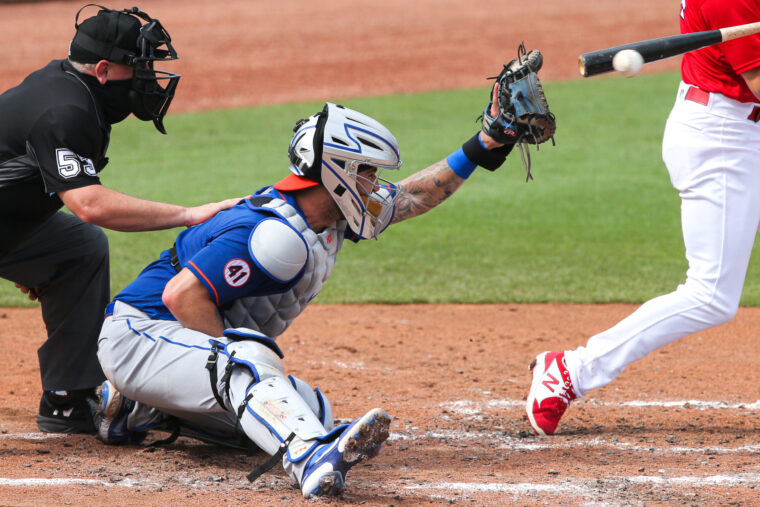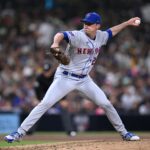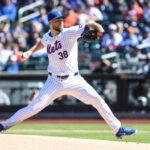
Credit: Sam Navarro-USA TODAY Sports
Francisco Álvarez may be the Mets’ future behind the plate, but at least one New York catcher made a case to keep him in the minors a bit longer.
Baseball Savant, the website that houses metrics and insights from MLB’s Statcast technology, introduced a new catcher blocking leaderboard. The stat tracks a catcher’s proficiency in preventing wild pitches (WP) and passed balls (PB) compared to expected.
Per the website, “Every pitch is assigned a probability of being a passed ball or wild pitch based upon several inputs, most notably: pitch location, pitch speed, pitch movement, catcher location, and batter/pitcher handedness. Based on that knowledge, each pitch a catcher receives (or fails to) is credited or debited with the appropriate amount of difficulty. For example, if a catcher blocks a pitch that is a PB + WP 10% of the time, he will receive +0.10. If he blocks a pitch that is a PB + WP 90% of the time, he will receive +0.90.”
It is important to understand that the expected metric accounts for the difficulty of the block. If a catcher is catching pitchers whose balls don’t move all that much or aren’t that difficult to catch, the metric will account for that. It gives a better understanding than just looking at the catcher’s raw PB + WP count.
The 2022 leaderboard features a familiar name near the top.

Tomás Nido is known as a defensive catcher, and this is one statistical backing for that reputation. In 2022, based on the pitches Nido caught, he was expected to receive 28 wild pitches and passed balls. His actual number of 16 gave him 12 blocks above average, tied for the fourth-best total among all catchers. This saved the Mets three runs, tied for the second-most. On a per-game basis, Nido had 0.16 blocks above average, the fifth-best mark.
Meanwhile, Nido’s compadre behind the plate, James McCann, was one of the worst catchers in baseball in this category. McCann had -6 blocks above average, which tied for 57th out of 66 qualified catchers. He was expected to have 15 PB + WP but instead allowed 21. His -0.12 blocks above average per game ranked 60th.
Omar Narváez, the Mets’ new backstop who will likely split playing time with Nido behind the plate, was dead average in this category last season, netting 0 blocks above average and 0 blocking runs. He was expected to have 26 PB + WP and had exactly that number.
One interesting note in this breakdown is the rate of easy, medium, and tough opportunities that each catcher had and what they did with those opportunities. Here is the rate breakdown and (in parentheses) the blocks above average for Nido, McCann, and Narvaez from 2022:
- Nido: 94.9% easy (38th), 6 BAA (T-10th); 4.3% medium (17th), 4 BAA (8th); 0.7% tough (56th), 2 BAA (T-4th)
- McCann: 96.2% easy (7th), 1 BAA (T-28th); 2.9% medium (60th), -3 BAA (T-56th); 0.8% tough (49th), -4 BAA (T-61st)
- Narváez: 95.9% easy (T-11th), 4 BAA (T-12th); 3.1% medium (T-54th) -4 BAA (60th); 1.0% tough (T-25th, -1 BAA (T-35th)
In other words, all three catchers were above average when it came to easy blocks, although Nido faced a far lower rate of easy ones than the other two. Whether easy, medium, or hard blocks, Nido had a top-10 number of blocks above average. McCann and Narváez, meanwhile, fell off sharply on medium and hard blocks.
This goes to illustrate how much more valuable Nido was than McCann in blocking last season. Considering the poor offensive output from the pair, Nido likely should have been the clear starting catcher.
Why is Blocking Important?
Wild pitches and passed balls obviously have an important effect on a game, but they don’t just impact the box score. When a pitcher knows that his catcher can block the ball, he feels more confident to throw his best stuff, nasty or liable to bounce as it may be. With Kodai Senga‘s “ghost fork” pitch coming into play, for example, it’s important to have a catcher who will be able to block it, particularly since it seems Senga does not have such great command of the pitch.
Other Defensive Factors
It is important to note that blocking is not the only function of a catcher. Pitch framing has taken center stage in this area in the analytics era, and calling a good game still matters a lot. Throwing out attempted basestealers is likely to take on more importance with the rules restricting throws over to first and the slightly larger bases.
In the area of framing, Narváez and Nido were almost equally strong in 2022; Narváez ranked seventh with six catcher runs, while Nido was right behind him, ranking eighth with five. Nido ranked fifth with a 50.4% strike rate, while Narváez was seventh with a 49.9% rate. According to FanGraphs Baseball’s framing metric, Narváez and Nido ranked eighth and ninth at 7.5 and 7.2, respectively.
Nido’s pop time to second base (1.96 seconds, ranked 29th) was far superior to Narváez’s (2.01 seconds, 61st). Nido also had the fastest exchange time in all of baseball at 0.63 seconds, while Narváez was tied for 21st at 0.72 seconds. Neither one has a particularly strong arm, as Narváez’s 79.0 mph average ranked 62nd, while Nido’s 77.4 ranked 75th.
Overall, Nido ranked eighth among catchers with a 14.8 defense number, while Narváez ranked 14th at 11.2. Cumulatively, these are two strong defensive catchers. However, Nido has the edge in most areas and is still a far stronger blocker.
2023 Usage
Figuring out how to use Narváez and Nido might be trickier than last year with McCann and Nido.
For one thing, Narváez is a left-handed batter while Nido bats right-handed, making a platoon split more likely. Additionally, Narváez is coming off a terrible offensive season in which he hit .206/.292/.305/.597, but his career batting splits of .258/.343/.386/.728 are far superior to Nido’s .220/.257/.323/.580.
If Narváez can get anywhere near his career marks, let alone his career year of .278/.353/.460/.813 in 2019 with Seattle, the Mets will find it difficult to justify sitting him.
Furthermore, with Álvarez waiting in the wings, every bad offensive series by the pair will have fans clamoring for Álvarez’s elevation from the minors. The Mets’ biggest offensive deficiency is in the power department, and it’s easy to foresee a scenario in which Álvarez’s minor league home runs are juxtaposed with the major league catchers’ output to demonstrate the urgent need to bring up the 21-year-old.
However, barring injury or defensive implosion, it’s likely that the Mets will continue to deploy the Nido-Narváez pairing for most of the 2023 season. The Mets have placed a premium on defense for their prospects, and they certainly do not seem eager to rush Álvarez.
One way or another, expect Nido to be the primary catcher when Senga is behind the plate due to his blocking abilities. His defense will continue to keep him employed as a catcher well into the future, and the Mets are more than glad to have his services.













